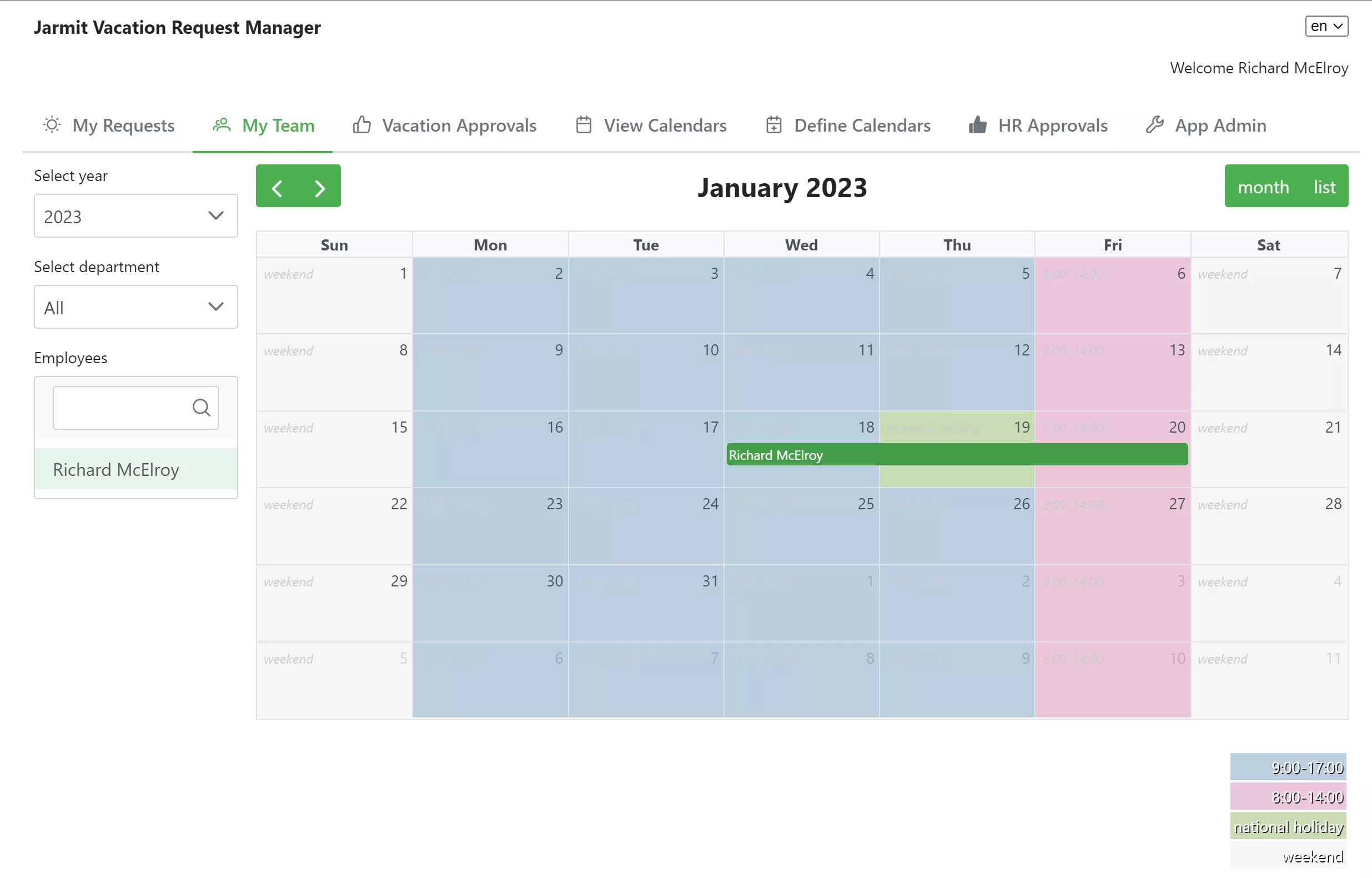
Vacation Request Manager
Everyone needs holidays! And companies need to be able to manage their employees vacation request to know who will be working when and not fall into the trap of having positions uncovered while the business is open.
Jarmit Vacation Request Manager allows you to prepare your company calendar with different numbers of working hours for different days, set the different holidays which apply to your employees and the total number of holiday hours for that year.
Each employee can then set the days they want off and send it to their manager (defined by the manager in their profile) for initial approval, who receives an automatic email notification.
The manager has a handy multi-calendar view to help them make sure they have all the positions they need covered each day by combining multiple employee calendars into one, simple calendar view.
Once approved by the manager, HR finalizes the vacation requests and the employee is notified by email.
If either the manager or HR have reason to refuse the vacation request, the employee is notified by email and can change their request accordingly.
Powerful, simple and efficient – the Jarmit Vacation Request Manager is an easy-to-install solution for SharePoint Online with a multilingual interface in English and Spanish.
For a version of the application compatible with SharePoint 2016, 2019 or SE or if you need it in another language, just get in touch.
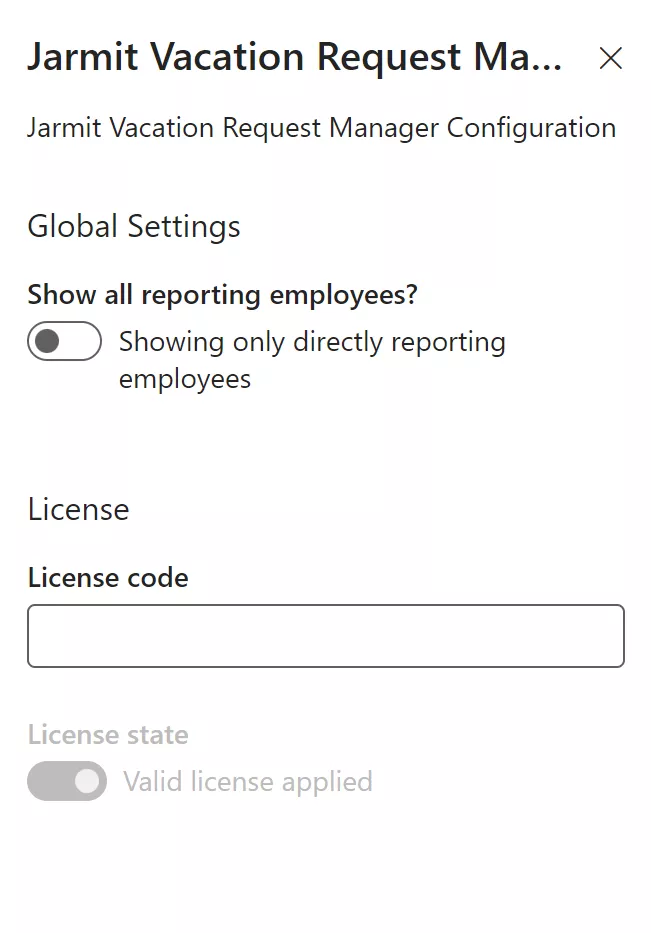
The Property pane
The Jarmit Vacation Request Manager property pane has two sections: global settings and license settings.
Global Settings
There is only one global setting available in the property pane: Show all reporting employees?
Setting this to ‘Showing only directly reporting employees’ will limit the list of employees shown to a manager in their ‘team view’ to those who are directly below them, and will not show employees who are further down the company hierarchy.
If you change this setting to ‘Showing all reporting employees’, a manager will see all the employees below them, not just those directly reporting to them.
License Settings
Finally, the licensing section of the property pane allows you to add your license code, which we send you after purchasing.
The license state will show you if a valid license has been applied or not.
The ‘Apply’ button at the bottom saves your web part configuration.
How it works
The Jarmit Vacation Request Manager has several different sections which are shown to a user depending on their role in the application (app administrator, HR or normal user) and if they have employees reporting to them.
Links to each section appear at the top of the application in the menu bar.
The user who adds the Jarmit Vacation Request Manager to a SharePoint site page for the first time automatically becomes an application administrator and has access to all the sections and can act on behalf of HR if they are not available.
After adding the application to a SharePoint site for the first time (detailed installation instructions below), the first port of call is the ‘app admin’ section. This is where a user with the ‘app admin’ role can access the SharePoint lists that are created automatically when it is added to a page in a SharePoint site.
The special users and working days lists are explained below. Links to the other lists where information about the general calendar configurations and user calendars are saved are provided to allow easy exporting of the data for external analysis if required.

The special users list
The ‘App special users’ link opens the SharePoint list where an app administrator can specify which other users are app admins or have the role of HR.
At least one admin and one HR user must be specified.
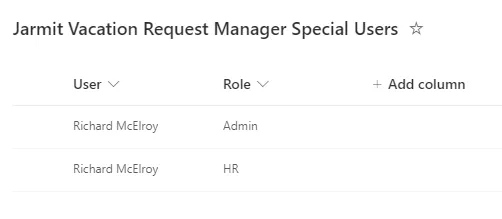
Types of working days list
The ‘working days’ list allows an app admin to define what types of working (and non-working) days are available to use in defining the company calendar.
How you decide to name the different types of days is entirely up to you. You might use the start and end times or names such as ‘8 hours with lunch break’ – whatever is best understood in your organization.
For each type of day, you also must specify the number of hours and assign that type of day a color. The color is set in the standard CSS #rgb format with hexadecimal values. To help in choosing your colors, you can use Google’s built-in color picker by searching for ‘css color picker’ in google.com
Two types of day which you will almost certainly need are ‘national holiday’ and ‘weekend’. If your organization doesn’t work on the weekend, specifying a type of day called ‘weekend’ with zero hours will allow you to easily set Saturdays and Sundays. Similarly, for national holidays when your company is closed, adding a national holiday type also with zero hours will let you take these days into account when configuring the next years general calendar.
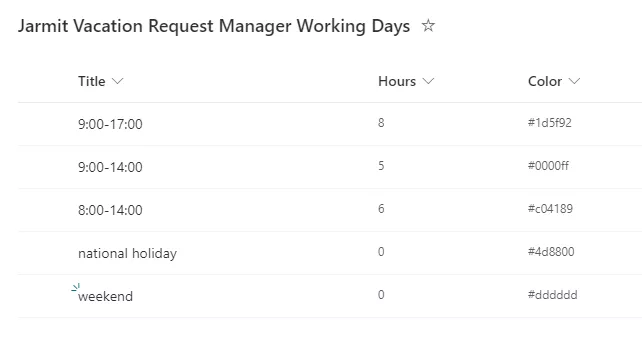
Define Calendars
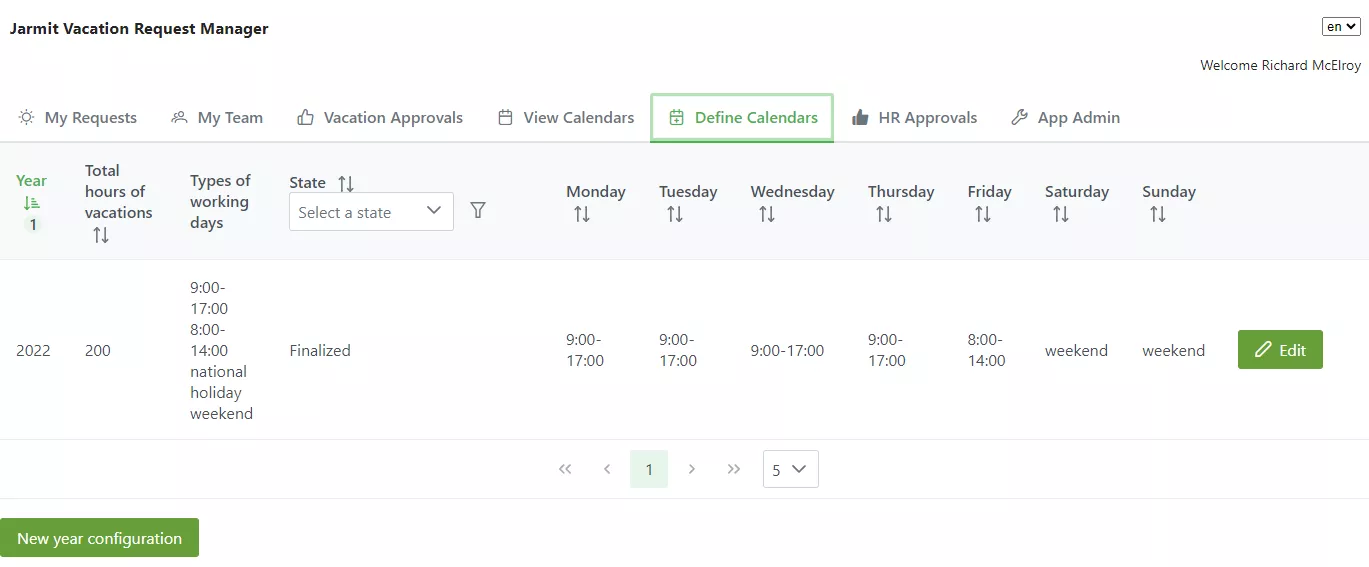
After adding application administrators and HR users, the HR users can start to define the years general calendar. This is the base calendar on which the employees will request their vacations, and each day of the year will have a type of working day set to it.
This section shows a summary of all previously configured years with a button to edit any years configuration and has a button below to create the configuration for a new year.
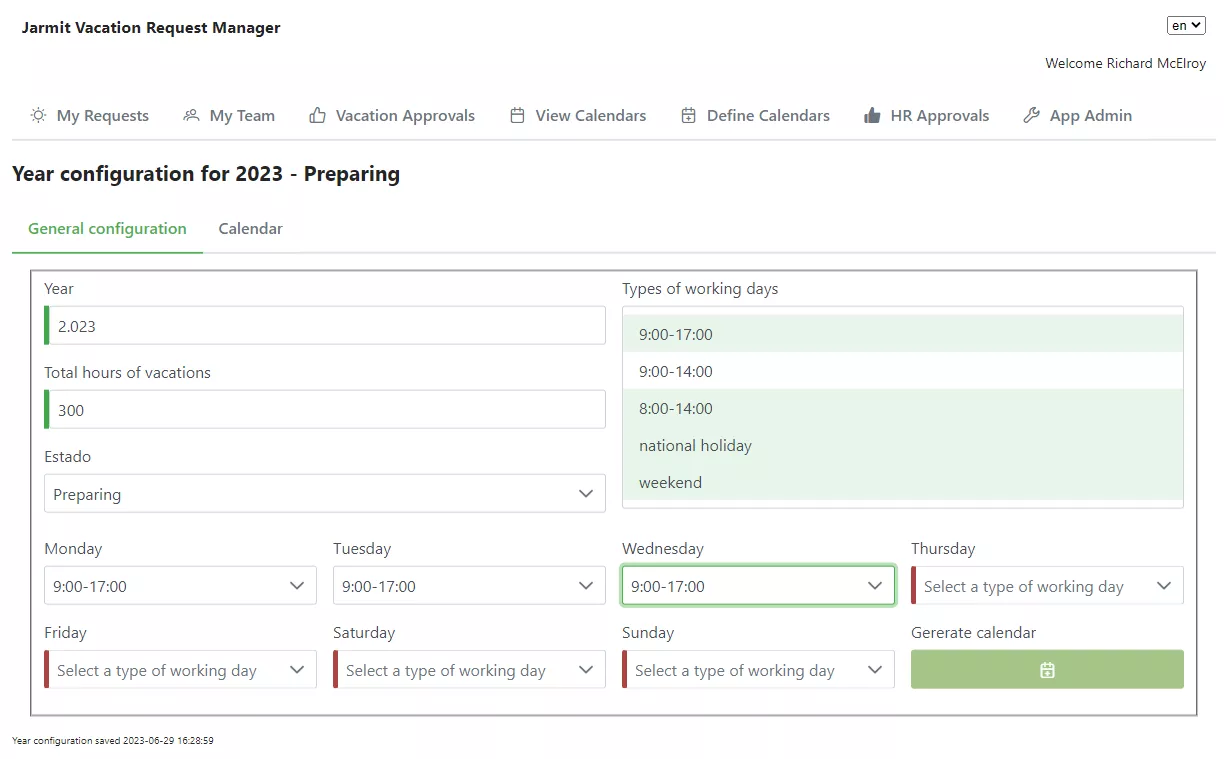
When you add a new year configuration or edit one created previously, there are two parts to the year configuration: the general configuration and the calendar view.
In the general configuration you set the year, the total number of hours of vacations the employees have available, which types of working days can be used in the year and preset which types of working days will be set for each day of the week.
The preset for each day of the week is used when you click the ‘generate calendar button to pre-configure the general calendar year with this type of working day. If your company doesn’t work during the weekend, this is where a working day definition of ‘weekend’ with zero hours is useful.
Once the base for the general calendar has been generated with the presets for each day of the week, you can go to the ‘calendar’ view to modify specific days.
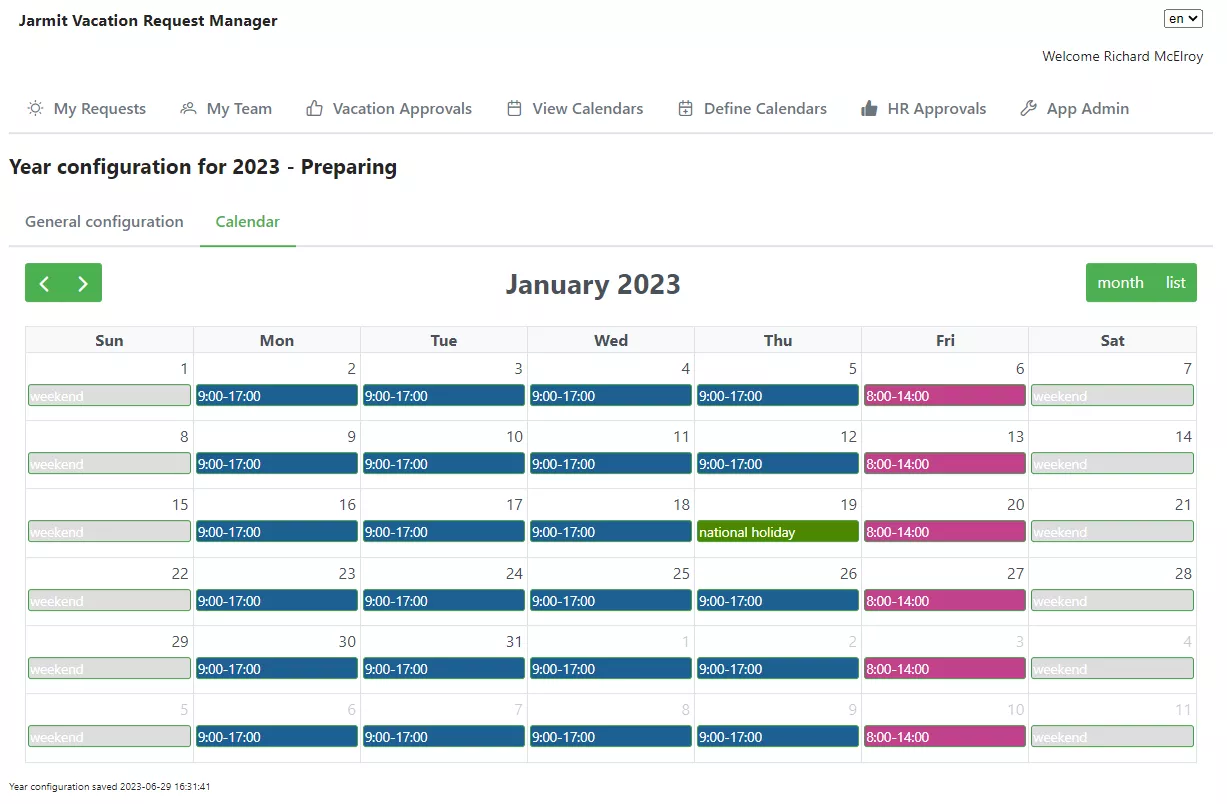
With working day types preset for each day of the week, the only thing left to do is change specific days to take into account days such as national holidays or days with different working hours, such as reduced working hours for organizations in summer in hot climates.
To do this, you click on the bar showing the type of working day current selected for that date and in the dialogue that appears, select a different type of working day.
Once the calendar has been updated to accurately reflect your companies calendar, it can be activated for all employees by returning to the general configuration tab and changing the state of the calendar from ‘preparing’ to ‘finalized’.
Now the users who can access the application can generate their own vacation calendars based on this configuration.
If your organization has different calendars for different employees, you can add the application to additional SharePoint sites and configure different year calendars for each collective of employees as required.
My Requests
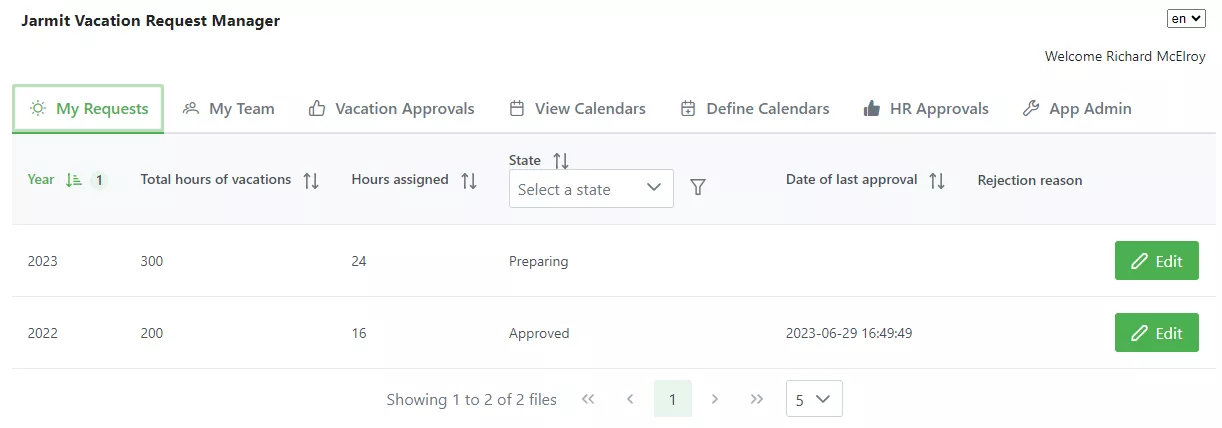
Once the year calendar has been defined and finalized by HR, the employees can start to request vacations. In the ‘My Requests’ tab, years that have been started will appear below to be activated and once activated they appear in the list as above.
This summary indicates how many hours of vacation time has already been allotted and the current state of the users request. Clicking on the ‘Edit’ button opens that years calendar.
Editing the user calendar

The image above shows the user calendar as viewed by an application administrator. Normal users will only see the buttons that they can use according to the current state of their calendar.
The colors chosen during the general calendar definition are reflected as the background color for each day, with a reference table below it.
To select days to take for vacation, the user clicks on the first day and then selects the end date in the dialogue that appears.
Once they have finished selecting their vacation days, the user clicks the button ‘Send for approval’ which sends an email to the employees’ manager to notify them they have a vacation approval pending.
Manager Vacation Approvals

When a manager with vacation requests to approve opens the application, they will see the ‘Vacations Approval’ tab. Opening this tab will show a list of pending approvals.
To approve or reject a vacation request, the manager clicks on the ‘Edit’ button to open the users calendar as shown before. The manager can then approve the request and send it to HR for their approval by clicking the ‘Send for approval HR’ button, or if they want to reject the request, they can fill out the text box with the reason and click the ‘Refuse’ button.
The user will receive an email notifying them of the refusal and allowing them to open their calendar to modify their vacation requests before resending them for approval.
To help in deciding on approval of a vacation request, the manager can click on the ‘Show changes since the last approval’ button to see a list of the modifications made to the users calendar since the last approval.
My Team
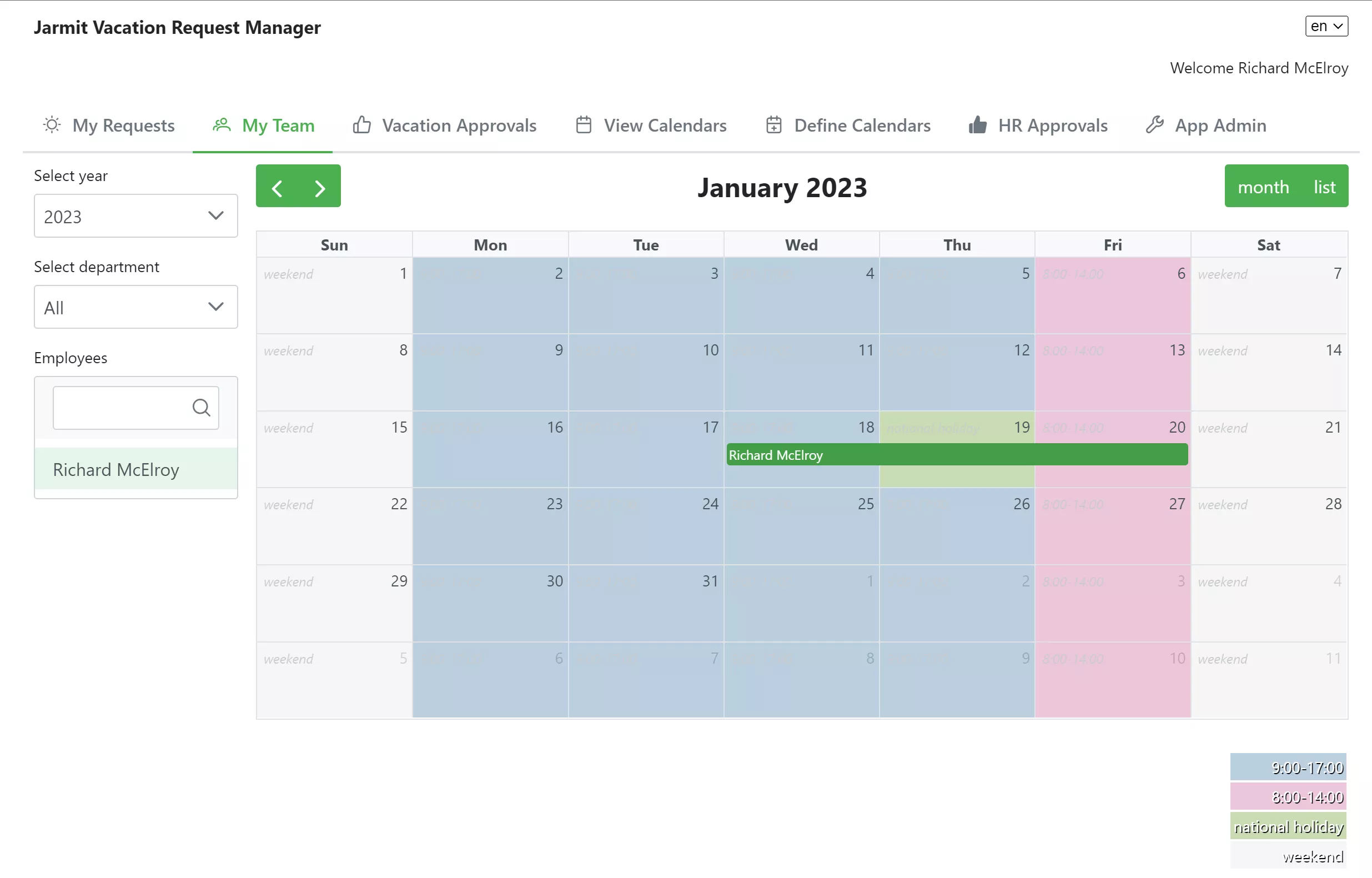
To aid in the process of approving vacation requests, the managers have a special view available to them which allows them to see the vacation calendars of multiple members of their team simultaneously. This allows a manager to easily detect unwanted situations such as having too few employees in the team working due to vacation overlap between other team members.
The global setting mentioned previously in the property pane of the application defines whether a manager sees just his direct team members or also other employees further down the company hierarchy.
In this view, the manager first selects the year, then the department they are interested in. You can also view employees of all departments below you if desired.
The list of employees is updated, and clicking on an employee name will add their calendar to the view. Clicking again on the employee name will remove their calendar.
If the list of employees is long, a search box exists to aid finding the desired employee quickly.
HR Approvals

The same as a manager’s vacation approvals view, HR have their own HR Approvals tab showing the list of pending vacation approvals for them to either approve or reject.
Clicking the ‘Edit’ button on an employee vacation request will open the corresponding vacation calendar as before and the vacation requests can be reviewed, approved or rejected with the employee receiving an email of the outcome.
HR's Calendars view
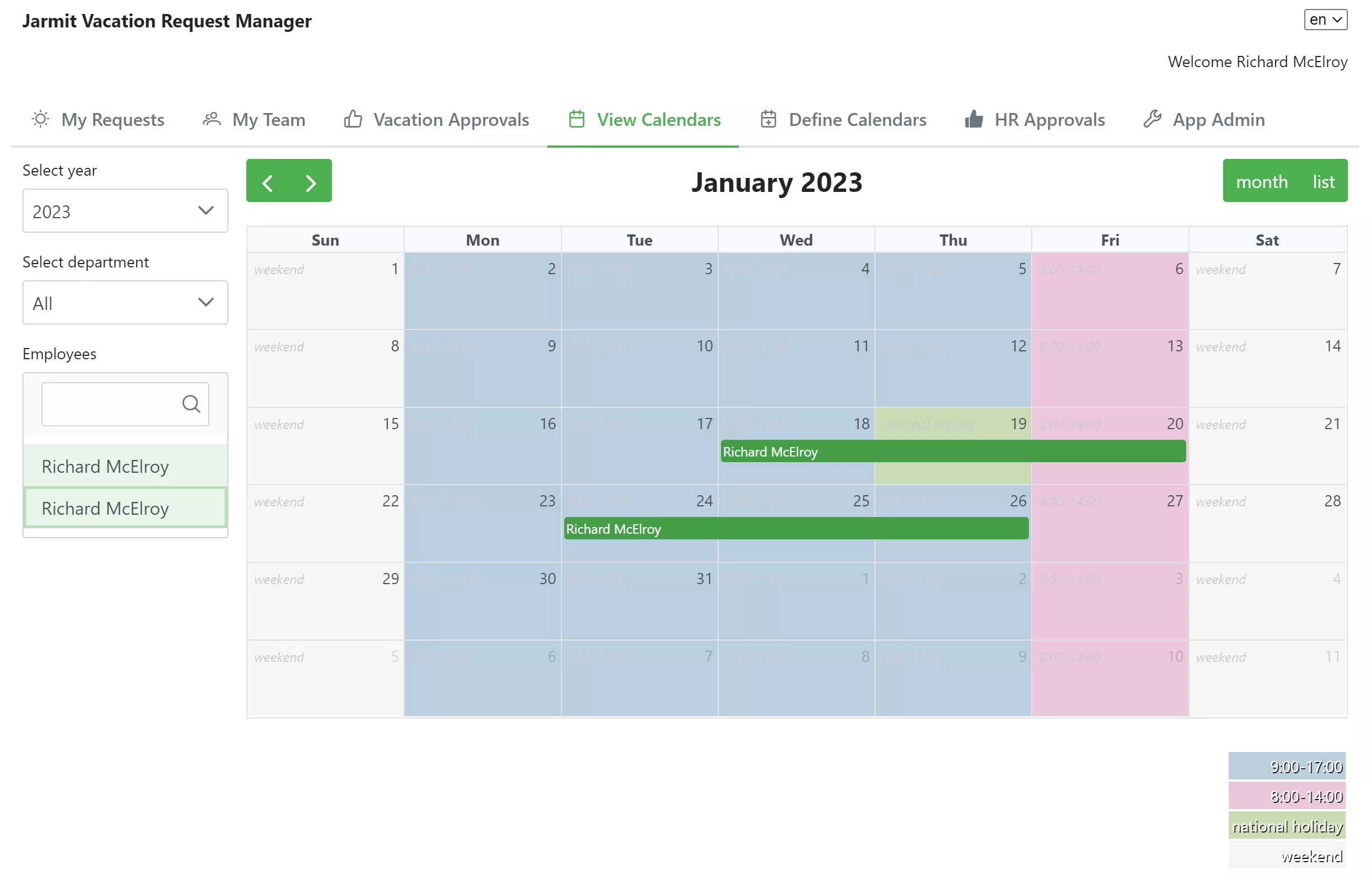
Once again, very similar to the manager’s ‘my team’ view, HR have a tab that allows them to combine multiple employee vacation calendars in the same view to aid in the process of deciding to approve or reject vacation requests.
The difference between this view and a manager’s team view is that HR has access to all departments and employees calendars.
Customization
While the approvals process implemented here is quite generic (manager then HR approval), your organization may have a different process that it wants to follow.
We can easily modify this application to implement the steps you would like to follow, just get in touch and lets us know your requirements.
Installation instructions
Fill out the registration form below and click the button to download a zip file containing the .sppkg SPFx solution file.
This solution will only work in SharePoint Online. If you are interested in a version for SharePoint 2016/2019/Subscription Edition, or support for a language other than English and Spanish, please let us know.
If you wish to deploy this solution to your entire SharePoint Online environment, you need to add this solution to your tenant app catalog.
To do this, you must be a SharePoint Administrator or a Global Administrator.
If you do not yet have a tenant app catalog (usually created at the URL https://your-tenant.sharepoint.com/sites/appcatalog) you can create one easily.
- Open your SharePoint administration site (https://your-tenant-admin.sharepoint.com/)
- In the left sidebar, select ‘More features’
- Then locate the section ‘Apps’ and select ‘Open’.
This will start the automatic creation of the tenant app catalog if it does not exist.
You can also install this solution in a site level app catalog if you only want it to be available in specific SharePoint sites.
For more information on how to create site collection app catalogs and how to use them, please read this Microsoft article.
When you add the .sppkg file to the app catalog, you will see a deployment dialog. To make the Jarmit Vacation Request Manager web part directly available to all SharePoint sites, you can check the ‘Make this solution available to all sites in the organization’ setting.
If you don’t check the ‘Make this solution available to all sites in the organization’ setting during deployment, you can add the web part to individual SharePoint sites by going to the site contents page, and select New -> App.
The new modern experience will show a list of solutions you can add to the site. Click the ‘Add’ button underneath the Jarmit Vacation Request Manager solution.
It will take a few seconds for SharePoint to add the web part to the site. Once it appears in the site contents page, you can add it to a SharePoint page.
While editing a SharePoint page, you can find the Jarmit Vacation Request Manager web part in the toolbox in the ‘Advanced’ section.
Alternatively, this solution has been prepared to allow it to be included in a SharePoint ‘single app page’. This is a SharePoint page with only one web part and takes advantage of the full page width.
To create a single app page for the Jarmit Vacation Request Manager, simply select ‘Page’ from the ‘New’ dropdown on the home page of the SharePoint site, then in the ‘Apps’ tab, select the Jarmit Vacation Request Manager.
NOTE: The single app page experience in SharePoint Online is relatively new and has a couple of problems Microsoft still have to fix. To avoid errors adding the Jarmit Vacation Request Manager to a single app page, first add the web part to a normal SharePoint Page in the same site. This page can then be deleted and you can safely create a single app page using the Jarmit Vacation Request Manager solution.
When you add the web part to a page, you start a 14 day fully functional trial period. After 14 days, the web part will cease to work and display a ‘trial finished’ message.
After purchasing a license, you can edit the page, open the web part property pane and copy the license code into the text box to activate the license. Your current web part configuration will not be affected.

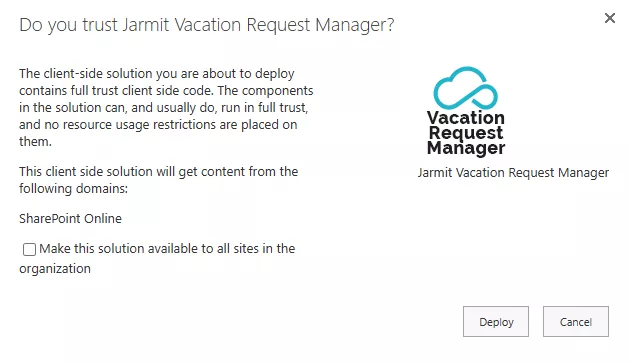
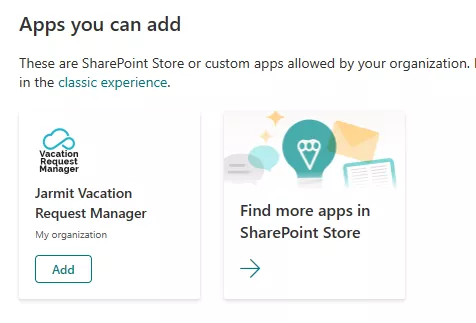
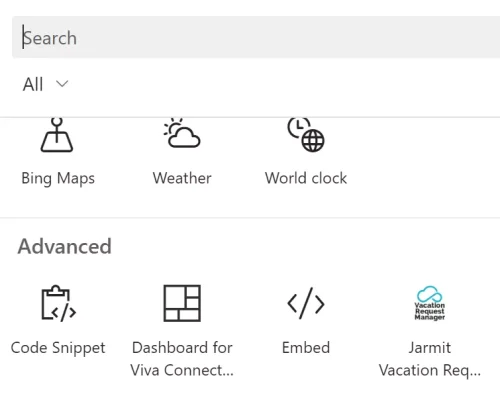
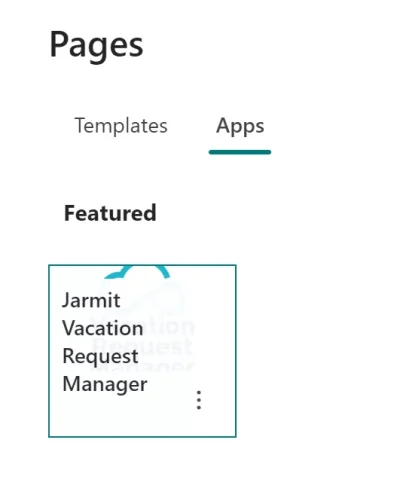
Pricing
(<50 employees)
- Unlimited use in 1 Microsoft 365 tenant
- Installation and 1st configuration included
- Free updates
- Email support
- 1 free lifetime subscription to 365Desk.io
(50-499 employees)
- Unlimited use in up to 2 Microsoft 365 tenants owned by the business
- Installation and 1st configuration included
- Free updates
- Email support
- 1 free lifetime subscription to 365Desk.io
(>500 employees)
- Unlimited use in up to 5 Microsoft 365 tenants owned by the business
- Installation and 1st configuration included
- Free updates
- Email support
- 1 free lifetime subscription to 365Desk.io
Special pricing for charity organizations is available – contact us for more information.
Registration Form
To download the Jarmit Vacation Request Manager application, please fill out the following form.
Use your Microsoft 365 email to register and receive 1 free lifetime subscription to 365Desk.io (limit 1 per Microsoft 365 tenant).
